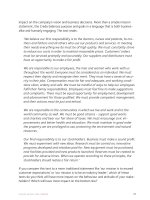Principles of business law
Bạn đang xem bản rút gọn của tài liệu. Xem và tải ngay bản đầy đủ của tài liệu tại đây (1.48 MB, 453 trang )
Diploma
in
Business Administration
Study Manual
PRINCIPLES OF BUSINESS LAW
The Association of Business Executives
William House • 14 Worple Road • Wimbledon • London • SW19 4DD • United Kingdom
Tel: + 44(0)20 8879 1973 • Fax: + 44(0)20 8946 7153
E-mail: • www.abeuk.com
© Copyright RRC Business Training
© Copyright under licence to ABE from RRC Business Training
abc
All rights reserved
No part of this publication may be reproduced, stored in a retrieval system, or transmitted in
any form, or by any means, electronic, electrostatic, mechanical, photocopied or otherwise,
without the express permission in writing from The Association of Business Executives.
ABE Diploma in Business Administration
Study Manual
PRINCIPLES OF BUSINESS LAW
Contents
Study
Unit
Title
Syllabus
Page
i
1
Nature and Sources of Law
Nature of Law
Historical Origins
Sources of Law
The European Community and UK Law: An Overview
1
3
6
9
13
2
Common Law, Equity and Statute Law
Custom
Case Law
Nature of Equity
Application of Principles of Equity
Equity and Common Law
Classification of Equity
Legal and Equitable Rights
Nature of Statute Law
Interpretation of Statutes
Codification and Consolidation
Appraisal of Statute Law
Delegated Legislation
23
25
26
32
34
36
37
38
39
41
44
45
46
3
The Administration of Justice
Organisation of the Courts
Administrative Justice
Public International Law
Judges and Juries
Organisation and Role of the Legal Profession
49
50
61
64
65
67
4
The Law Relating to Associations
The Concept of Corporations
Corporations in Law
Companies
Companies in Law
Unincorporated Associations
Partnerships
75
77
79
81
86
95
96
Contents (Continued)
Study
Unit
Title
Page
5
Contract Law 1: Fundamentals of Contracts and their Creation
What is a Contract?
The Agreement
Classification of Statements and Terms
Consideration
The Intention to Create Legal Relations
Capacity to Contract
103
105
109
116
119
127
129
6
Contract Law 2: Contract Regulations
Privity of Contract
Joint Obligations
Assignment
Mistake
Misrepresentation
Undue Influence
Void and Illegal Contracts
133
135
140
141
144
151
153
157
7
Contract Law 3: Performance and Discharge
Performance
Discharge by Agreement
Discharge by Breach
Discharge by Frustration
Remedies for Breach of Contract
167
169
172
174
176
182
8
The Sale of Goods 1: The Contract, Property and Title
Sale of Goods
Distinction between Sale and Other Supply Contracts
Formation of Contract of Sale
Passing of Property
Transfer of Title by Non-Owners
191
193
196
198
201
213
9
The Sale of Goods 2: Terms and Conditions
Risk
Frustration
Delivery
Acceptance and Payment
Statements Relating to Goods
Statutory Implied Terms as to Description and Quality
Exemption Clauses
217
219
221
223
227
229
232
239
Contents (Continued)
Study
Unit
Title
Page
10
The Sales of Goods 3: Disputes and Remedies
Remedies of the Seller
Remedies of the Buyer
Supply of Goods and Services Act 1982
Role of the Commercial Court
Resolution by Arbitration
Rules for the Conduct of Arbitration
Arbitration Proceedings
Rights and Duties of Arbitrator
Arbitration Awards
247
249
257
259
260
261
263
266
266
269
11
Law of Agency 1: Agency Agreements and Agents
General Nature of Agency
How Agency Arises
Ratification
Categories of Agents
Duties of Agents to their Principals
Rights of Agents against Principals
Commercial Agents (Council Directive) Regulations 1993
271
273
275
278
281
284
290
294
12
Law of Agency 2: Authority, Liability and Termination
Authority of Agents
Delegation of Authority
Rights and Liabilities of Principal to Third Parties
Liability of Principal for Wrongs of Agent
Relations between Agents and Third Parties
Termination of Agency
297
299
303
304
305
307
311
13
Employment Law 1: The Contract of Employment
Distinction between Independent Contractor and Employee
Other Categories
The Need to Distinguish between Categories
Contract of Employment
Equal Pay
Other Terms and Conditions
315
317
320
322
323
327
329
Contents (Continued)
Study
Unit
14
Title
Page
Employment Law 2: Termination of the Contract, Discrimination and
Tribunals
Notice
Written Statement of Reasons for Dismissal
Constructive Dismissal
Redundancy
Unfair Dismissal
Employment Tribunals
Race Relations Act 1976
Sex Discrimination Acts 1975 & 1986
Disability Discrimination Act 1995
Health and Safety at Work Act 1974
335
337
338
338
339
341
344
347
351
355
358
15
Principles of Consumer Credit
Hire Purchase
Consumer Credit Act 1974
The Consumer Credit Agreement
Withdrawal and Cancellation
Rights during the Currency of the Agreement
Obligations of the Creditor in relation to the Quality (etc.) of the Goods
363
364
364
371
373
375
378
16
Consumer Protection
Introduction
Trade Descriptions Act 1968
Fair Trading Act 1973
Consumer Safety
The Role of Local Government
Manufacturers and Product Liability under the Law of Tort
381
382
382
386
389
393
394
17
Negotiable Instruments 1: Bills of Exchange
Introduction
Characteristics of a Bill of Exchange
Acceptance
Transfer of Bills of Exchange
Inland and Foreign Bills
Methods of Discharge
Liability of Parties on the Bill
Release from Liability
Liability “outside” the Bill
Forgeries
Dishonour of a Bill
Consequences of Dishonour
Incomplete Bills and Alterations
399
401
401
404
407
410
411
412
416
417
417
419
421
423
Contents (Continued)
Study
Unit
18
Title
Negotiable Instruments 2: Cheques
Introduction
The Nature of a Cheque
Banker/Customer Relationship
Crossing a Cheque
Special Protection of Paying Banker
Special Protection of Collecting Banker
Promissory Notes
Page
427
429
429
431
434
436
439
440
i
Diploma in Business Administration – Part 2
Principles of Business Law
Syllabus
Aims
1.
Acquire an understanding of the principles of Common Law system within the students’ own
legal system and how it affects their business life.
2.
Acquire a knowledge of the legal environment in which businesses operate in the domestic and
international market place.
3.
Acquire an understanding and practical application of the principles and concepts of the system
of justice within the business community.
4.
Acquire an understanding of the principles and practical implications of the law of business.
5.
Acquire an understanding and practical application of the principles and concepts of the law of
contract.
6.
Acquire an understanding and practical application of the principles and concepts of the law for
the protection of the customer and final consumer.
7.
Acquire an understanding and practical application of the principles and concepts of the law of
employment and industrial relations.
8.
Acquire an understanding and practical application of the principles and concepts of the law of
tort as it applies to the world of business.
Programme Content and Learning Objectives
After completing the programme, the student should be able to:
1.
2.
3.
©
Comment on the basic elements of the Common Law system and the language it uses
within a domestic and international market
!
sources of law – common law and equity; statutes and delegated legislation and statutory
interpretation
!
recognise the differences between civil (in the Common Law sense) and criminal law;
comment on the differences between contract and tort
Comment on the administration of the law
!
the court system
!
alternative dispute resolution
!
discuss the personnel of the law – judges, barristers, solicitors, legal executives, paralegals
Comment on the application of the courts’ decisions
!
apply case law
!
able to cite facts and ratios and where possible contrasting cases
!
extrapolate from decisions into hypothetical situations
Copyright ABE
ii
4.
5.
6.
7.
8.
Comment on the law of associations; the separate legal concept and its implications for
the business and the customer and the final consumer
!
recognition of the sole trader – definition, creation, trading position, legal liability
!
a partnership – essential elements, the partnership contract, relations with the partners
between themselves and to outside world, fiduciary obligations
!
companies – classification of registered companies; formulation, memorandum of
association and articles of association, the doctrine of ultra vires and the recent changes
in the law; the nature and form of the company securities; the management of the
company, company meetings; the regulations governing and the powers and duties of
directors and shareholders
Recognise, give guidance of and discuss the rules of contract
!
the basic law of contract
!
offer – acceptance
!
intention to create legal relations
!
consideration
!
formality of contract
!
capacity
!
terms and conditions, conditions and warranties, exclusion clauses, the battle of the
forms
!
vitiating factors, mistake and misrepresentation, undue influence; contracts in restraint of
trade
!
discharge of the contract
!
remedies in common law and equity for breach of contract
Recognise and give evidence of Consumer Protection
!
special contracts – sale and supply of goods and hire purchase; definition and nature
!
conditions and warranties, transfer of title of goods and risks associated with such a
transfer, delivery and acceptance of goods
!
remedies
!
loans, hire purchase and other credit and consumer credit agreements
Recognise and be able to discuss the law with regard to agency
!
agency – definition; creation
!
authority of the agent; rights and duties of the principal and agent; types of agency
!
termination of the agency contract
Recognise, give evidence of, discuss and examine the principles relating to consumer law
!
common law
!
statutory legal principles
!
case law
©
Copyright ABE
iii
9.
10.
Recognise and explain the rules relating to the law of employment and industrial relations
!
contract of employment – definition, nature and formation; express and implied terms,
equal opportunities and discrimination and their implications, termination of an
employment contract by agreement, dismissal and redundancy
!
employment tribunals and appeals
Recognise and explain the law regarding bills of exchange
!
the concept of negotiability; definition and purpose of a bill of exchange; duties and
liabilities of the parties
!
cheques – crossings
!
relationship of bankers and customers; protection of bankers and customers; charge cards
and credit cards
Method of Assessment
By written examination. The pass mark is 40%. Time allowed 3 hours.
The question paper will contain:
Eight questions of which five must be answered. Each question carries 20 marks.
Reading List:
Essential Reading
!
Kelly, D. and Holmes, A. (1997), Principles of Business Law, 2nd Edition; Cavendish
Publishing Ltd., London
!
Kelly, D. and Holmes, A. (1998), Questions and Answers Business Law; Cavendish Publishing
Ltd., London
Additional Reading
!
Ellison, J., Bedingford, J. and Hardson (1997), Business Law, 4th Edition; T, Harrison Law
Publishing, BEP, Sunderland
!
Dobson, P. (1997), Charlesworth’s Business Law, 16th Edition; Sweet and Maxwell, London
©
Copyright ABE
iv
©
Copyright ABE
1
Study Unit 1
Nature and Sources of Law
Contents
A.
B.
C.
D.
Page
Nature of Law
3
Definition
3
Classification of Laws
3
Criminal and Civil Liability
4
The Set of Rules
5
Objectivity
5
Enforcement
5
Impartiality
5
The Rule of Law
6
Historical Origins
6
The Anglo-Saxons
6
The Danes
6
Position Before the Norman Conquest
6
The Normans
7
Curia Regis
7
Itinerant Judges
8
Court of Admiralty
8
The Law Merchant
8
Canon Law
9
Court of Chancery
9
Sources of Law
9
Unwritten Law
10
Written Law
10
The Pattern of English Law
11
European Community Law
11
The European Community and UK Law: An Overview
13
Composition of the European Community
13
Institutions of the European Community
13
(Continued over)
©
Licensed to ABE
2
Nature and Sources of Law
Application of Community Law
14
The European Community and Interpretation of Law
15
Parliamentary Sovereignty and the European Community
15
Single European Act 1986
16
The Treaty on European Union 1992 (The Maastricht Treaty)
18
European Communities (Amendment) Act 1998
22
©
Licensed to ABE
Nature and Sources of Law
3
A. NATURE OF LAW
Definition
The word “law” is difficult to define, particularly as it is used in many different ways. It contains,
however, the concepts of orderliness, universality and objectivity. It is concerned with behaviour and
not with causes, and either contains an element of inevitability, e.g. scientific laws, such as the laws
of gravity, or of sanction, e.g. divine laws.
Some philosophers have postulated the existence of natural law by which they mean the Law of God
which regulates the actions of mankind. This concept is often known as the principles of natural
justice.
In the narrower concept of law, there must be a set of rules which can be applied objectively with
someone to enforce them.
There have been many attempts to put these into a workable definition, some more successful than
others. One of the better is that of Salmond:
“Law consists of any principle which is recognised and enforced by the
courts in the administration of justice”.
Another, which is possibly superior to that of Salmond, since it has a slightly wider application, is
that of James:
“A body of rules for the guidance of human conduct which are imposed
upon and enforced among the members of a given state”.
Classification of Laws
Salmond, after stating that law in its general sense includes any rule of action, says that it includes
the following categories:
!
Imperative Law
These are rules of action imposed on men by authority, e.g. by the state.
!
Physical or Scientific Law
These are rules which formulate the uniformities of nature, e.g. the law of gravitation. You can
distinguish them from man-made laws, in the sense that they merely state observations on a
state of affairs that already exists.
!
Natural or Moral Law
These are rules formulating the principles of natural justice. This conception of law is derived
from Greek philosophy and Roman law, and has found more favour with Continental jurists
than in English jurisprudence. It overlaps to some extent with physical or scientific law. In the
English language, law and justice are two separate words, showing that we recognise them to
be two separate things – a distinction that is not made in most other languages.
!
Conventional Law
These are rules agreed upon by persons for the regulation of their conduct towards each other.
Agreements entered into by, for example, the parties to a contract or members of a company
(who agree to be bound by the rules of its Articles of Association) are enforceable under the
©
Licensed to ABE
4
Nature and Sources of Law
law of the land. Other agreed systems of rules, e.g. the rules of a football club or the laws of
chess, may not be enforceable by law.
!
Customary Law
These are rules of action embodied in custom. We shall consider later the importance of
custom in the development of the English legal system.
!
International Law
These are rules which govern sovereign states in their relations with each other.
!
Civil Law
This is the law of the state, as applied in the state’s courts of justice. It is into this category that
English law falls.
Criminal and Civil Liability
In essence, it can be said that a crime is a wrong against the state, while a civil wrong is one
against an individual.
You should note the following major distinctions:
!
State Action and Private Action
In the case of a crime, whilst under certain circumstances an individual may prosecute, the
prosecution will normally be brought by the state. In a civil wrong, such as breach of contract,
the injured party may bring an action against (or “sue”) the party liable, and may recover
damages or other forms of satisfaction.
!
Redress and Punishment
The purpose of a civil action is to redress a wrong, whereas the aim of a criminal prosecution is
to punish the wrongdoer, to prevent him from repeating his crime and to discourage others
from committing similar crimes.
!
Settlement and Withdrawal
A criminal action can be withdrawn only with the leave of the Crown, whereas the plaintiff
(note that the term complainant is now preferred and will be used in this module) in a civil
action can settle out of court or withdraw his claim at any time.
!
Indictment and Writ
Criminal proceedings are initiated by indictment or summary procedure, whereas civil
proceedings are commenced by action resulting from the issue of a writ.
A fundamental difference thus exists between criminal law (dealing with crimes) and civil law
(dealing with civil wrongs) and each branch is, in general, administered by different courts on
different principles.
Criminal law is concerned with offences against the state, i.e. crimes such as murder, housebreaking, theft. The more serious criminal cases are dealt with by a judge and jury; less serious
offences (the overwhelming majority) are dealt with by magistrates. The two parties are the
prosecution and the accused. The prosecution is conducted on behalf of the Crown via the Crown
Prosecution Service, in important cases by the Attorney-General. If the accused is found guilty by the
jury, he is sentenced by the judge; if he is not proved guilty, he is acquitted.
©
Licensed to ABE
Nature and Sources of Law
5
Civil law is concerned with private litigation, e.g. breaches of contract, disputes concerning property.
The complainant issues a statement of claim, setting out the facts he alleges against the defendant and
asking for damages or other remedy. The defendant puts in his defence to the allegations of the
complainant. The case is then tried by a judge and jury, or by a judge sitting alone, without a jury.
Today, there is normally no jury in civil cases, unless one of the parties makes special application that
a jury should be summoned. If there is a jury, it decides the facts of the case and the judge decides
the law. The judge then, if the jury has found for the complainant, will make the appropriate order,
and usually awards the complainant his costs. It is the jury, however, which fixes the amount of the
damages. If the case goes in favour of the defendant, the judge will normally award the defendant his
costs to be paid by the complainant. Should the judge be sitting alone without a jury, he decides both
fact and law, the amount of damages, and deals with all matters.
The Set of Rules
Law, then, must consist of a set of rules which are known or readily discoverable by those who must
obey them. It is, of course, a maxim of English law that “ignorance of the law is no defence”.
However, this does not mean that each citizen is expected to know all the rules which are in force –
which is clearly impossible – but that knowledge of them is available, since they are all published.
The citizen, therefore, must have a general idea of the principles upon which English law is built, e.g.
rights of property, person, contract, and he must be prepared to consult an expert in law for finer
points, when necessary. A permitted defence of ignorance of the law would, clearly, make the
administration of justice impossible.
Objectivity
“No man can read the thoughts of another” is a principle of wide application in law. Clearly, no
authority can impose sanctions upon the thoughts of its subjects, although in some societies in the
past this has been attempted. The law will recognise motives but only as far as they are apparent and
can be imputed from the actions following them. In other words, it is with actions, and not with
thoughts and feelings, that law is concerned.
Enforcement
It is essential, if law is to operate efficiently, that it should operate only within an area controlled by
an effective government. This may vary for different laws, since there may be different authorities
operating within the same area, e.g. state law and federal law in the United States of America, and
bylaws of local authorities in England – but, nevertheless, the principle of territorial limits is
preserved. If a government loses control of an area of its territory, in that portion its law will not
prevail.
It is the duty of the government of the area concerned to make its laws effective by establishing a
judicial machinery for the investigation of alleged breaches of the law and for the enforcement of the
law by sanctions, i.e. penalties or rewards designed to influence the human will to conform to the law.
Impartiality
Although it is not an essential component of law, in most civilised countries it is regarded as
fundamental that the rules of law should apply to all citizens alike. This principle of impartiality is
one of the principles of natural justice which has influenced English law in particular.
©
Licensed to ABE
6
Nature and Sources of Law
The Rule of Law
The rule of law is an essential doctrine of the British constitution. It is not a written code of rules but
a general principle implicit in the common law which the courts will apply, unless some statute can
be quoted modifying its application. It has three important aspects:
(a)
No person can be punished except for a definite breach of the law, established in the ordinary
law courts of the land.
(b)
No person is above the law and everyone must bear the legal consequences of his own acts, i.e.
there is equality before the law.
(c)
There is an absence in the UK of any special body of courts to try cases where the citizen is in
conflict with the government unlike in France where litigation between citizens and state
officials is dealt with by special administrative courts.
It is often said that it is from the principle of the rule of law that all forms of British liberty – personal
liberty, liberty of speech and of the press, liberty of meeting and discussion – are derived.
During the 20th Century the growth of the welfare state was necessarily accompanied by a huge
increase in legislation and a corresponding increase in the state's interference in the lives of
individuals. To this extent the rule of law may seem to have been eroded, but it is still valid and of
importance.
B. HISTORICAL ORIGINS
Since the development of English law has been a gradual process, we shall give a brief account of its
historical origins before discussing the various streams which, together, make up the whole.
The Anglo-Saxons
In the early days, after the Saxon conquest of England in the 5th to 7th centuries, there was no law in
the modern sense. The tribal chiefs, aided by the experienced “elders” of the community, were the
depositories and guardians of the ancient customary law or “custom”, and enforced the observance of
such customs or usages dealing with religion, morality and sanitation by applying sanctions of
various kinds. At a later stage, from the 9th century onwards, the Saxon kings began to put many of
the old customs into writing. Such compilations are generally referred to collectively as the laws of
the Anglo-Saxons. Although occasionally such collections refer to changes made by a powerful king
(and this gives a hint as to the future of law), they were promulgated as existing laws confined to preexisting customs. New laws were exceptional, although the conversion to Christianity naturally
introduced fresh concepts issuing from divine revelations. Such codifications were not classified:
criminal law, civil law, ecclesiastical law, procedure, public law, etc. were all intermingled.
The Danes
The Danish invaders brought a second element into English law, and the great legislator, King Cnut,
crystallised this Scandinavian importation in the laws of the Danelaw north-east of Watling Street
where the Danes lived under their old Norse customs.
Position Before the Norman Conquest
By the middle of the 11th century, the time of the Norman Conquest, the local customary laws had
crystallised into the laws of Mercia, the laws of Wessex and the laws of the Danelaw, all separate
districts of England. Note that there was no law common to the whole land. The laws were scattered
©
Licensed to ABE
Nature and Sources of Law
7
on all sides: in counties or shires, hundreds (divisions of a shire) and boroughs (towns) there was
material ready to be transferred into a single system of law by a centralising agency. This material
was largely made up of customs administered by the freemen of the district in the local courts of the
county or shire, the hundred and the borough.
The Normans
It was the task of the Norman kings, who seized control of England from 1066, through their judges
to weld these customs into a uniform mass, the common law of the realm. In this way the state took
over and enforced summary rules of conduct which were originally formulated spontaneously by the
people themselves for regulating their actions and behaviour.
The Norman Conquest was a vital incident in the development of English law. However, William the
Conqueror did not violently impose a foreign system of law on the conquered inhabitants. He
expressly announced that all men were to enjoy the laws of Edward the Confessor, a previous king.
William’s statutes, in so far as they were legal enactments, were restorations of the old law of
accepted tradition, i.e. the preservation of the “rights they held on the day when King Edward was
alive and dead”.
Before the Conquest, as we have seen, there was no law common to the whole of England but many
local customs, varying from place to place; remember that, under the Anglo-Saxon regime in
England, there were local shire and hundred courts. Immediately following the Norman Conquest,
these became strengthened. The Anglo-Saxon “shire-reeve” became the Norman sheriff, a royal
officer responsible to the King. The hundred court had petty civil and criminal jurisdiction in the
villages and townships, while the shire courts had a more extensive jurisdiction, and also heard
appeals from the hundred courts. As a result of this extension of their jurisdiction, the courts met
more frequently than in Anglo-Saxon times.
William I, a man of high political wisdom, realised that he must unify the English people by a strong
government. National unity could be achieved only by the methodical fusion of diverse local
customs into a common law, running through the whole length of England. This process of
unification was largely completed by his great successors, Henry I, Henry II and Edward I, and by the
middle of the 13th century there had been established a system of royal courts of justice dispensing a
common law of the realm.
Curia Regis
The supreme court in England under the Norman kings was Curia Regis, or the King's Council. It
consisted of the royal household, officers of state, such as the Justiciar and the Chancellor, and the
judges. This body exercised judicial, legislative and administrative functions. The Council was
originally an advisory body which the kings consulted on matters of state, and through which orders
were issued to be executed at local level. It was also, however, a body in which royal justice could be
secured. It tried all cases in which the Crown was directly interested, e.g. crimes of a varying nature,
breaches of the King’s peace and infringements of the King’s proprietary rights but, in addition, for
ordinary people, it was an emergency court of last resort when all other methods of justice had failed.
The courts of the shire, the hundred and the major remained, with the Norman sheriff as the head of
the first two, but there was now an ultimate appeal to the royal court.
Do not confuse Curia Regis with Magnum Concilium (the Great Council) which consisted not only
of officials and judges but also of all the tenants-in-chief or great barons who held their lands direct
from the King.
In time, Curia Regis became the Privy Council and Magnum Concilium turned into Parliament.
©
Licensed to ABE
8
Nature and Sources of Law
Gradually, there emerged from Curia Regis three separate courts.
!
The Court of Exchequer
This court’s principal jurisdiction was that of royal revenue but later it acquired a jurisdiction
in cases of debt between citizen and citizen. In early times, the judges were badly paid and
depended largely on court fees for their remuneration, and as a result judges tried to attract
litigants to their court. The Court of Exchequer came in time to take many cases of debt which
should have been heard in the Court of Common Pleas (see below). It would sell the writ to
commence the action for a sum slightly below the charge demanded by the Court of Common
Pleas.
!
The Court of Common Pleas
This court’s jurisdiction was to hear civil cases between citizen and citizen. At a later time, it
tended to interfere with the jurisdiction of the Court of Admiralty to hear cases that were also
within Admiralty jurisdiction.
!
The Court of King’s Bench
This court’s jurisdiction was “pleas of the Crown”, i.e. criminal cases. In addition, however, it
came to supervise inferior courts by prerogative writs, enjoyed certain jurisdiction for appeals,
and took certain cases which were within the jurisdiction of the Court of Common Pleas.
Itinerant Judges
Early in Norman times, the King began to send out bodies of royal officials, known as
commissioners, to perform various duties in his name, e.g. the compilation of Domesday Book, and
soon this custom developed into a regular system of itinerant justices, who were royal judges
travelling periodically round the kingdom to hear legal and financial disputes in the shires. This
system familiarised the justices with the varying local customs, which they would naturally discuss
among themselves on their return to Westminster between the circuits, when they would hear cases in
the King’s central courts.
Centralisation of power naturally led to a desire for uniformity in administration, and this was
brought about as these itinerant justices and the sheriffs accumulated and fused local practices and
made them applicable to the whole realm, first in the royal courts and then by their gradual
application of these merged local customs to the shires. Here we have the origin of the common law
of the land. Royal justice superseded all other justice and the surviving customary law was the
custom of the King’s court put into shape and authoritatively laid down by the judges, but of native
origin in its essence.
Court of Admiralty
About 1341, the King conferred jurisdiction on the Admiral, which the latter exercised through
deputies. The Court of Admiralty exercised criminal jurisdiction over offences committed on the
high seas, and also a civil jurisdiction of an ill-defined nature. During the 16th and 17th centuries, it
took to hearing mercantile cases from the old Courts Merchant and superseded these courts.
The Law Merchant
There existed in England, as abroad, various local courts which were mercantile(concerned with
trade) and administered a body of mercantile law which was recognised in England, as on the
Continent, as a definite body of customary law applicable to merchants of all nations attending the
great international fairs and markets.
©
Licensed to ABE
Nature and Sources of Law
9
The Courts Merchant existed in the seaport towns and in the fairs and markets where foreign
merchants tended to resort. Foreigners in the Middle Ages would be unwilling to submit their
disputes to purely national tribunals. Furthermore, what the merchant wanted was a system of speedy
justice, so that differences could be settled quickly, and he could depart.
The law administered in the Courts Merchant was truly of an international nature. The courts in
Bristol, say, would enforce the same mercantile rules as the courts in Barcelona or Venice. English
law of bills of exchange and negotiable instruments has come to us through the Lombardy merchants
attending England's great international fairs.
Courts Merchant flourished in England from the Norman Conquest onwards but they were driven out
of existence during the 16th and 17th centuries through the encroachment of the Court of Admiralty.
However, the Law Merchant itself was saved since Lord Mansfield, who died in 1793, incorporated
it into the common law. He declared that the Law Merchant was part of the common law and, in
consequence, mercantile cases came to be heard in the common law courts, the latter keeping the
Admiralty jurisdiction in check. Mercantile law, which has much foreign custom as its basis, has
become a specialised subject and has taken on an especially English character.
Canon Law
This is the law relating to matters over which the church assumed jurisdiction. It was formulated by
ecclesiastical lawyers, mainly on the basis of Roman law, and consisted of the decrees of the general
councils of the Catholic church and declarations of the various Popes. It was administered in special
ecclesiastical courts which were established in Norman times.
Differences frequently arose between the spiritual courts, as they were called, and the royal or lay
courts, for the church claimed and exercised jurisdiction not only in obvious church matters, such as
the discipline of the clergy and the validity of marriages, but also over such civil matters as wills of
personal property and the distribution of goods of deceased persons.
By the time of the Reformation and of the Civil War (16th and 17th centuries), the royal courts
achieved supremacy over the church courts which, in course of time, lost nearly all the important
jurisdiction that they formerly laid claim to. Nevertheless, much of the canon law has become part of
the law of the land and may be considered an indirect source of part of English law.
Court of Chancery
The Court of Chancery grew up in the 14th century as a result of the defects in, and the rigidity of,
the common law, in which there were only a limited number of writs or forms of action. As a result,
many cases of hardship and injustice went unremedied and finally, under Edward III, the Chancellor,
who was until the time of Henry VIII always an ecclesiastic, began to hold his own court with
litigants presenting petitions for special relief. The basis of the law administered by the Chancellor
was conscience, and this led to principles and conclusions opposed to common law, since the aim was
to secure moral justice, rather than to follow legal rules. This system of law administered by the
Court of Chancery became known as equity.
C. SOURCES OF LAW
Now that we have given a brief outline of the historical origins of the English courts, we are in a
position to discuss the various sources from which English law is derived.
©
Licensed to ABE
10
Nature and Sources of Law
Unwritten Law
!
Common Law
The common law, as we have seen, was originally based on the merging of the various local
customary laws of England as a result of the decisions of the royal judges. In fact, in the law
report of Henry IV in the 15th century it is said:
“The common law of the realm is the common custom of the realm”.
It is therefore unwritten, since it depends originally upon a judge's interpretation of the customs
of the realm. When we come to discuss the importance of case law in the English judicial
system, we shall show that the decisions of judges are, in fact, binding, but this does not
invalidate the fact that the basis of common law, which has also absorbed mercantile law and
some canon law, is essentially unwritten, although cases heard in the courts appear in written
law reports. The reports only relate the unwritten law.
You should note, at this point, that the expression “common law” has come to be used in four
distinct senses, as follows:
!
Historically, as above, to denote the body of law common to all England that arose to
supplant the previous local systems of law.
!
As opposed to equity (see below).
!
As opposed to statute law, also considered below.
Thus, in this sense, it is sometimes said that a certain rule of common law was modified
by an Act of Parliament.
!
To mean the whole body of English law, including equity and statute law, as
distinguished from any foreign system of law. Thus, we frequently speak of “the
common-law countries”, meaning England, the USA and those Commonwealth countries
which have adopted English law, especially when we wish to contrast them with
European countries, such as France and Germany, the legal systems of which have been
strongly influenced by Roman law.
Just as the Romans had their “jus civile” as the basis of their law, so English common law lies
at the foundation of the English legal system. The law of torts is almost wholly based upon the
common law, as is a good deal of English contract law. The common law has played its part in
the development of the complicated system of English land law, and has covered departments
of public law like constitutional law.
!
Equity
Like common law, equity is also based on judicial decision, and not upon written rules. It
originally stemmed from the Chancellor’s interpretation of what was fair and just according to
his conscience and, while in time it became rigid, it was originally flexible. Its basis is, again,
unwritten.
Written Law
We have not yet discussed statute law, because it was a later development than common law and
equity. It is true that, from Norman times onwards, decisions of the King-in-Council had the effect of
law, but the promulgation of new laws was very rarely carried out, and Magna Carta (1215) is
usually regarded as the first published statute.
©
Licensed to ABE
Nature and Sources of Law
11
A statute is a written law passed by the approved legislative process of the state, i.e. nowadays by the
Queen-in-Parliament, and it supersedes any other forms of law. Thus, statute law can override both
the common law and equity, since it is enacted by the sovereign power and is therefore superior to
custom and judicial decision.
Here, an important distinction must be made between “the law” and “a law”. The former is the
whole body of law, as defined at the beginning of this study unit, while “a law” is a written statute or
an order made on the authority of a written statute. Thus, “a law” refers only to statute law. You
need to understand this distinction clearly, since it sometimes serves as a basis for examination
questions.
It is important to appreciate that, since the UK is a member of the European community (EC), EC
legislation overrides English law, and English legislation must not conflict in any way with the
Treaty of Rome and its implementing legislation in the form of directives and regulations. To that
extent, EC law must now be regarded as a source of law in England.
The Pattern of English Law
From what we have already said, we can see that English law is composed of three strands. The bulk
of English law is common law, which is based on customs and case law. This is modified and
supplemented by equity, which is based on the principle of moral and abstract justice, rather than
upon customary law, and is again chiefly represented by case law. Finally, statute law, enacted by
the sovereign authority of the state, is increasingly important in the modern state and is superior in
status to both the common law and equity. The diagram below illustrates the pattern.
The Law
Statute Law
The Common Law
Equity
The supreme law
Custom
Case law
An addition to and
modification of the
common law
European Community Law
The accession of the UK to the European Community, on 1 January 1973, introduced a system of
supranational law in accordance with the Treaty of Rome (which established the EC in 1957) and the
UK’s Treaty of Accession. Since that date legislation has been passed, and continues to be enacted,
aimed at fitting Community law into the English system and the existing framework of parliamentary
sovereignty.
EC (or Community) law is either embodied in the Treaty of Rome – in which case it is often referred
to as the primary legislation of the EC – or it is derived from the Treaty, and termed secondary
legislation. The following are the principal forms of EC secondary legislation:
!
Regulations
Regulations have direct internal effect in member states. They are mainly “self-executing”,
although sometimes they may have to be supplemented by national legislation. In general, they
relate to detailed, technical aspects of the EC agricultural policy, transport, customs duties, etc.
©
Licensed to ABE
12
Nature and Sources of Law
!
Directives
Directives do not have direct internal effect but oblige the governments of member states to
ensure that the requirements laid down in them are fully implemented, usually by national
legislation. The directives state, in broad terms, what has to be done but leave to the member
states the details of implementation. Examples are the various directives on value added tax
and company law.
The European Court of Justice is the Community’s supreme judicial authority; there is no
appeal against its rulings.
!
Decisions
These are usually concerned with specific problems or issues, and they are not necessarily
directed to the Community as a whole. They may be addressed to the government of an
individual member state, in which case they impose binding obligations but do not have direct
internal effect as law in that state. Alternatively, they may be addressed to companies or
individuals in one or more member states.
Since the date of UK membership of the EC, the sources of Community law have become sources of
English law. The sources of Community law are essentially the Treaty of Rome (primary
legislation); secondary legislation (mainly regulations and directives); and precedents established by
the European Court of Justice, which constitute developing sources of law.
The European Court of Justice sits in Luxembourg, and consists of 13 judges and six advocatesgeneral; one judge and one advocate-general are from the UK. Its main function is to ensure that the
law is observed in the interpretation and application of the Treaty, and it is the final arbiter on all
legal questions falling within the scope of the Treaty. Apart from its role in interpreting Community
law, the Court deals with disputes between member states on Community issues, and between
member states and Community organisations. It also hears actions brought by a member state, by the
EC Commission, by the EC Council, or by any individual regarding matters covered by the Treaty.
Individuals and companies may challenge in the Court the legality of regulations, directives, etc. only
in so far as these are of direct concern to them.
One article of the Treaty of Rome, in particular, has an important effect on the administration of
justice by UK courts. Article 177 gives jurisdiction to the European Court of Justice to make
preliminary rulings on the interpretation of the Treaty, and the validity of actions taken by the
institutions of the Community. Where such a question is raised before any court or tribunal of one of
the member states, the court or tribunal may, if it considers that a decision on the question is
necessary to enable it to give a judgment, request the Court of Justice to give a ruling on it. If the
question of interpretation arises before a court from which no further appeal is possible in the
national court system, that court must submit a reference to the European Court of Justice.
Remember that all Community law overrides English national law, in the event of conflict or
inconsistencies. Furthermore, Parliament has a duty (under international treaty law) to refrain from
passing legislation conflicting with Community law. This duty has major implications as regards the
judicial interpretation of Acts of Parliament.
Referring to the Treaty of Rome, Lord Denning stated:
“In any transaction which contains a European element we must look to the
Treaty ....., for the Treaty is part of our law. It is equal in force to any
statute. It must be applied by our courts.”
Note, therefore, that Community law, future and present, is automatically binding in the UK, in many
cases without local enactments. Judicial notice is taken by English courts of such Community law.
©
Licensed to ABE
Nature and Sources of Law
13
Orders in Council and Regulations may be used in the UK to implement Community laws in matters
of detail. The whole of existing English law which was inconsistent with Community law was
repealed by implication on the UK’s accession to the EC.
D. THE EUROPEAN COMMUNITY AND UK LAW: AN
OVERVIEW
Because of the importance of the effect of EC law on UK law we shall look briefly at the composition
of the Community and its institutions, as well as some of the significant issues relating to the UK
legal system.
Composition of the European Community
When Parliament enacted the European Communities Act 1972, which came into effect on
1 January 1973, Britain became a member of the three European Communities:
!
European Economic Community (i.e. the Common Market or EC)
!
European Coal and Steel Community (ECSC)
!
European Atomic Energy Community (Euratom)
As a member state, Britain became subject to Community law. At the beginning of 2000 there are
15 countries in the European Community with a further 13 having submitted applications to join.
The EC is a separate legal entity in international law. As far as the UK is concerned, the country
acceded to the Treaty of Rome in 1971 and became a full member of the Community following the
European Communities Act 1972. The Community is made up of a number of component parts,
having legislative, executive and judicial functions, but the main purpose of the Community is
economic and political. The UK has to conform, along with other member states, to Community law,
and we will look at the conflict between national and Community law as regards the English legal
system later. We will first look at the various bodies making up the Community.
Institutions of the European Community
!
The Council of Ministers
This is the supreme legislative body, although its powers are limited by having to proceed on
proposals from the Commission on most matters. The role of the Council of Ministers is to
take executive and legislative decisions and co-ordinate the policies of member states, under
the terms of the Treaties.
The Council comprises government ministers from each member state and the presidency
rotates among them every six months. The Council is assisted by a small civil service of
permanent officials called the Committee of Permanent Representatives, with headquarters
in Brussels. The Council works in close co-operation with the Commission, discusses their
proposals and ensures that national interests are represented. The heads of government of
member states meet to discuss important issues at meetings called European Councils.
!
The Commission
The Commission is made up of individuals appointed by the member states, with
representation depending on the size of the member states. The numbers can be altered as new
states are admitted to membership. Individual members are appointed for a period of four
years. The President and Vice-President are appointed from amongst the members for a two-
©
Licensed to ABE
14
Nature and Sources of Law
year period. The members are chosen for their experience and total independence and are not
regarded as representatives of their respective governments. The Commission is aided by a
substantial civil service working in concert with the Council of Ministers and the Parliament
(see below). The Commission has executive functions, and ensures that the provisions of the
Treaty of Rome and other decisions of the Community are carried out. It also helps to draft
Community law.
It is misleading to view the Council as the legislature and the Commission as the executive,
since the Commission also has legislative powers and the implementation of policy is the
responsibility of the institutions of the member states. The Council enacts all important
measures but cannot amend Commission proposals except by unanimous agreement. The
Commission is the representative body with non-member states and administers Community
funds. It answers solely to the Parliament.
!
The European Parliament
This is the elected body of the Community, and consists of 628 democratically elected
European MPs (or MEPs) from each member state with 87 MEPs from the UK. It has
advisory and supervisory functions. It has no legislative powers – in fact, the only power it
has is to dismiss the Commission by a motion of censure passed by a two-thirds majority.
The general role of the Parliament is a consultative one, considering proposals from the
Commission before they are sent to the Council. A failure by the Council to seek the opinion
of the Parliament may leave their actions open to question.
!
The Court of Justice of the European Communities and the Court of First Instance
We looked at the composition and functions of the court earlier in the study unit.
!
The Court of Auditors
This court monitors all financial transactions in the European Union on behalf of taxpaying
citizens.
Application of Community Law
As we have already noted, EC law is distinct from national law but exists in parallel with it and,
where the two conflict, Community law prevails.
Some aspects of EC law are directly applicable in the UK (treaties and regulations) and confer rights
and duties which must be recognised by the courts of member states. They pass straight into local law
without the need for approval of the parliaments of member states.
Directives do not automatically become the law in member states but are instructions to make law
within the legislative machinery of each country within the prescribed time limit. Decisions are
binding on the member state or corporation within that state to whom they are addressed. Decisions
are usually of an administrative nature, e.g. granting authority for some action or providing
exceptions to a particular legal rule. Section 52(1), European Communities Act 1972 states:
“All such rights, powers, liabilities, obligations and restrictions from time
to time created or arising by or under the Treaties and all such remedies
and procedures from time to time provided for by or under the Treaties are
without further enactment to be given legal effect or used in the United
Kingdom, shall be recognised and available in law, and be enforced,
allowed and followed accordingly”.
Similarly, as regards secondary legislation, Article 189 of the EC Treaty states:
©
Licensed to ABE









